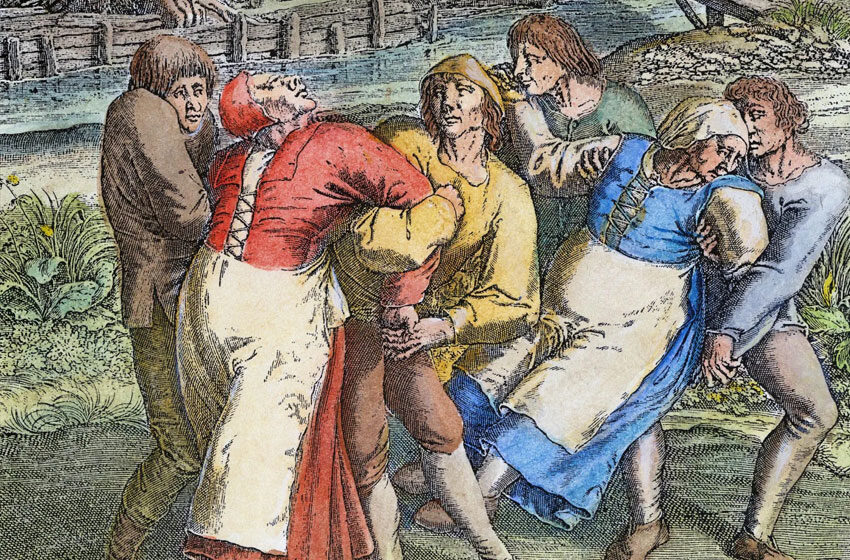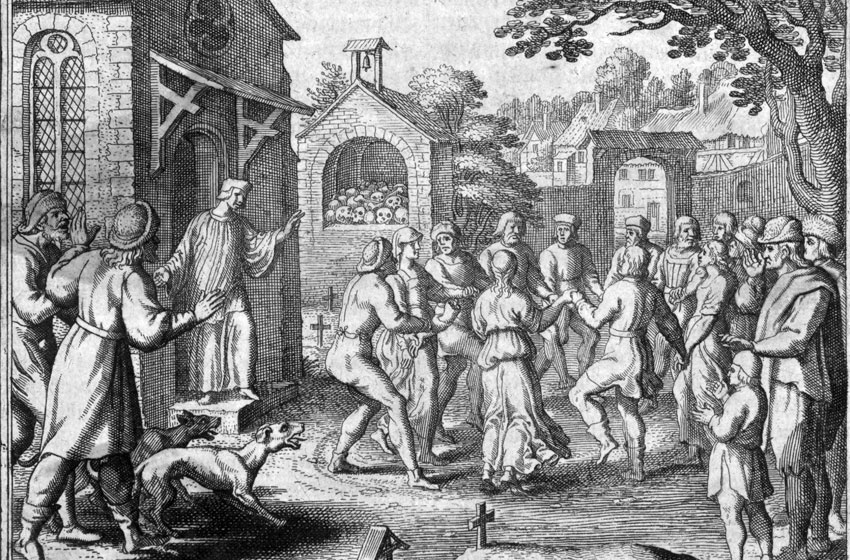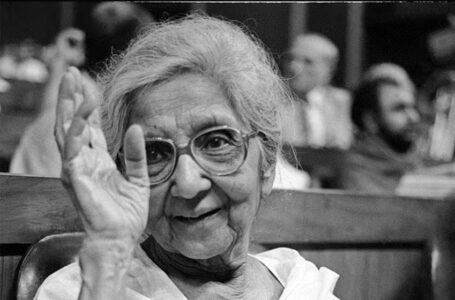A 400-year-old plague that continues to impact pop culture

Plagues have upended lives and left a trail of countless deaths and losses since time immemorial; the Covid-19 pandemic that swept the world in the last two to three years is a recent example. Also, epidemics are usually caused by insects, rodents, or other air-borne and water-borne microorganisms. However, the “dance plague” that occurred centuries ago in France did not happen due to any microorganisms; in fact, the plague’s origin has been researched and questioned for years to come.
Amidst the extreme heat of a hot summer day in July 1518, a woman called Frau Troffea came to a square in Strasbourg and began dancing. Initially, the spectators watched her intently with curiosity; she continued the unusual public display for nearly a week. Although she fell to the ground occasionally due to exhaustion, she was unbothered by her body’s warning signs, including fatigue, pain, hunger and shame. Also, an interesting thing to note was that there was no music; it was as if she danced to the rhythm of her heartbeat and let her body’s motion flow.
Eventually, when the authorities were alerted, they arrived to take her away, but they discovered that many others had joined her. Additionally, by the next month, hundreds of people like her took part in the frenzied dance; they could not explain why they were doing it but continued to dance with bloody feet and limbs twitching as if they were doing it compelled.
A poem from contemporary chronicles how the affected men and women danced in the market, alleys, and streets throughout day and night until the sickness stopped. Furthermore, the chronicle mentions that authorities took measures to end the illness by taking them to the St. Vitus’s shrine outside the city. The priests gave them small crosses and red shoes; similarly, the authorities made other arrangements, such as they appointed persons to dance with the affected people into submission. However, despite all efforts, the attempts to stop the sickness failed, and many people danced themselves to death.
What caused the dancing plague?
Four hundred years ago, the ”dance plague” took place in France and ever since then, researchers and historians have explored many theories to explain the origin and cause. Although presently it is the most famous example, Strasbourg was not the only dance plague to affect Europe during the medieval and early modern eras. Many instances of uncontrolled or threatening dancing were recorded in Germany, France, and other parts of the Holy Roman Empire. In earlier centuries, these events were interpreted as divine punishment or demonic possession, remedied with religious solutions like processions, masses, or direct intervention from priests.
Twenty years before the 1518’s summer, a cleric in Strasbourg named Sebastian Brant wrote in his satirical allegory The Ship of Fools that dance and sin are synonymous with each other. Also, he blamed Satan as the primary culprit who compels people who participate in rejoiceful dancing. Moreover, several years after the incident in Strasbourg, the physician Paracelsus embarked on a series of treatises on choreomania (dancing mania).
For instance, one of his famous treatises includes The Diseases That Deprive Man of His Reason, such as St. Vitus’s Dance, Falling Sickness, Melancholy, Insanity, and Their Correct Treatment. Furthermore, in his treatise, he indicated that a person’s “laughing veins” could provoke a “ticklish feeling” that rose from their limbs to their head, clouding judgment and prompting extreme motion until the frenzied blood calmed.
Paracelsus is best known for his pioneering work on chemistry in medicine, and he is one of the foremost contributors. They attempted to separate fiction from the reality of the situation as he pointed out the biological reasons behind the sickness rather than associating it with any divinity. Therefore, the logical interpretation aligns more closely with the current theories regarding mass psychogenic illness induced by febrile political and social circumstances.
For a considerable amount of time, there were conjectures about whether ergot – a mould found in rye stalks that could bring about powerful hallucinations and convulsions – might be responsible, but these have largely been dismissed. On the other hand, John Waller, the author of the most popular non-fiction book on the subject A Time to Dance, A Time to Die: The Extraordinary Story of the Dancing Plague of 1518, instead characterises choreomania as a “psychic epidemic” akin to others around the world involving other involuntary bodily responses such as laughing or fainting.

The cultural impact of the “dance” plague
A large mass of people dancing in a frenzy has been documented in at least six contemporary chronicles, wherein the dancer’s motions continued for weeks. However, Frau Troffea has been indicated to be the instigator for any such occurrences. Also, regardless of the accurate historical details, the story of the mad dancer continues to capture the people’s imagination from all walks of life.
A woman who lost herself in a captivating dance that transcended individual will and physical limitation, sometimes with deadly consequences. Furthermore, the event’s story consequently affected pop culture and literature and continues to do so till today. For example, Hans Christian Andersen’s fairy tale The Red Shoes tells the story of cursed scarlet leather slippers that condemn their owner into a dance so tortuous that she eventually finds an executioner to hack off her own feet.
“The Red Shoes” is a nightmarish tale with obvious moral implications that suggest the ultimate punishment for practising vanity. Also, the shoe wearer encounters such an ordeal because she wanted to possess the beautiful shoes in the first place. Additionally, its darker suggestions of possession and incessant movement have inspired numerous works, including a Powell and Pressburger film, a Kate Bush album, and several ballets.
Similarly, the summer of 2022 saw the release of Florence + The Machine’s fifth album Dance Fever, which takes hints from the unstoppable impulses of choreomania (the term “choreomania” is from the Greek choros (dance) and mania (madness)). Furthermore, the frontwoman of the indie rock band Florence Welch the album’s songs and music are a collective result of the combination of energetic motion and moral panic and “the whirl of movement and togetherness” that the singer missed because of the Covid-19 pandemic.
On the other hand, Kiran Milwood Hargave’s latest novel, The Dance Tree, explores the events of the 1518 Strasbourg incident from a third-person perspective. Also, in Hargrave’s fictional account of the story, the sickness affects only women, beginning with Frau Troffea. Then, the story continues through the eyes of Lisbet, a pregnant beekeeper who is hardened to losing and seeking to untangle the mysteries of the family she has married into.
Moreover, Lisbet is not a participant; she is an onlooker who observes how the manic dance changes the city’s nature and ultimately, it changes her too. The narrative flows smoothly with brief portraits of the women who join the dance:
- Women who have lost their fathers, their sons, or their minds.
- Women who have known passion, who have been denied it.
- Women who remain bystanders, until they can’t resist the promise of freedom found in the centre of a maddening crowd.
Beyond the sickness
Events or catastrophes of mass disorder have often been a source of inspiration for many artists worldwide; it is always fascinating to see or observe moments when people replace social conventions with bizarre and inexplicable happenings. Hence, besides highlighting a sense of trance and self-destruction, choreomania also projects physical protest.
Therefore, nowadays, “the dancing plague” might not seem as odd as it did a few years back; on the contrary, people look at it as liberate movement. Although unstoppable frenzied dance can be frightening, there is a sense of appeal to it.
What could happen if people allowed themselves to be wholly free-minded and let their bodies sway in continuous movements? What would happen if hundreds of people with similar feelings moved around the city?







